Canale L.C.F., Mesquita R.A., Totten G.E. Failure Analysis of Heat Treated Steel Components
Подождите немного. Документ загружается.

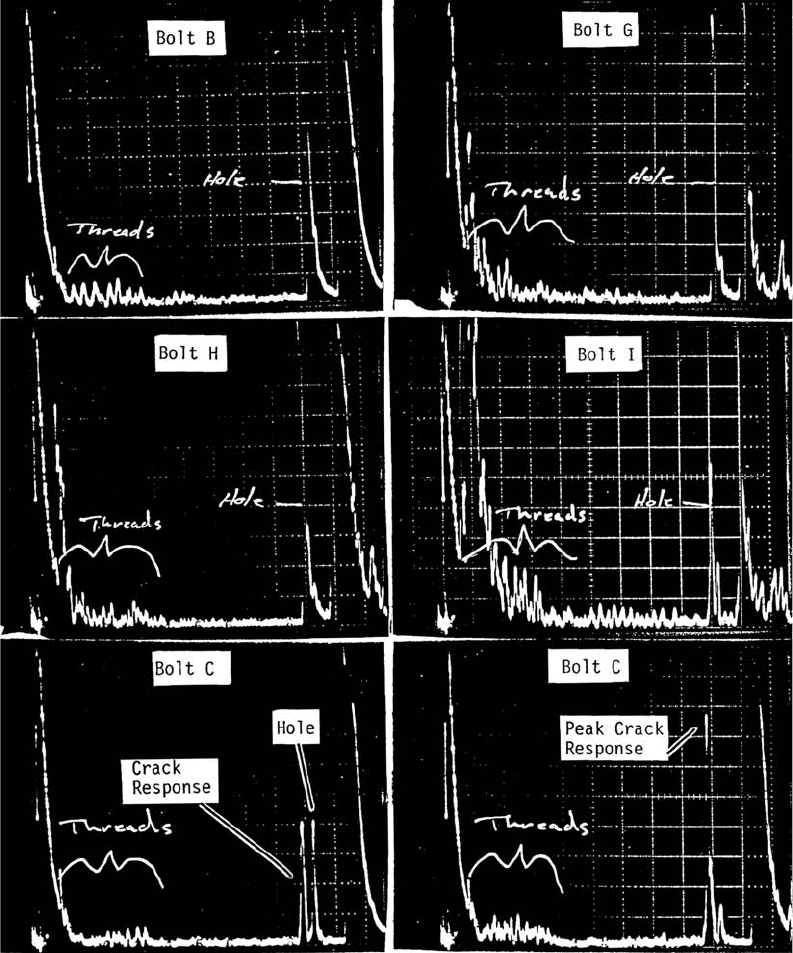
(Fig. 71). The fracture surface of crack G had the
characteristic ratchet marks or shear ridges that
indicate multiple initiation sites along the outer
edge of the bolt. The shape and appearance of
the exposed crack was indicative of fatigue.
Bolt H (Fig. 72) showed no crack indications,
using ultrasonic inspection or magnetic particle
inspection. This bolt showed significant cir-
cumferential scoring around the periphery of
the shank, at approximately the midpoint of the
shank. More general wear was seen on the shank
than bolt B. Because no crack indication was
seen by NDT, no additional work was performed
on this bolt.
Fig. 67 Ultrasonic signal responses for each bolt inspected
386 / Failure Analysis of Heat Treated Steel Components
Name ///sr-nova/Dclabs_wip/Failure_Analysis/5113_351-393.pdf/Chap_11/ 18/8/2008 3:48PM Plate # 0 pg 386
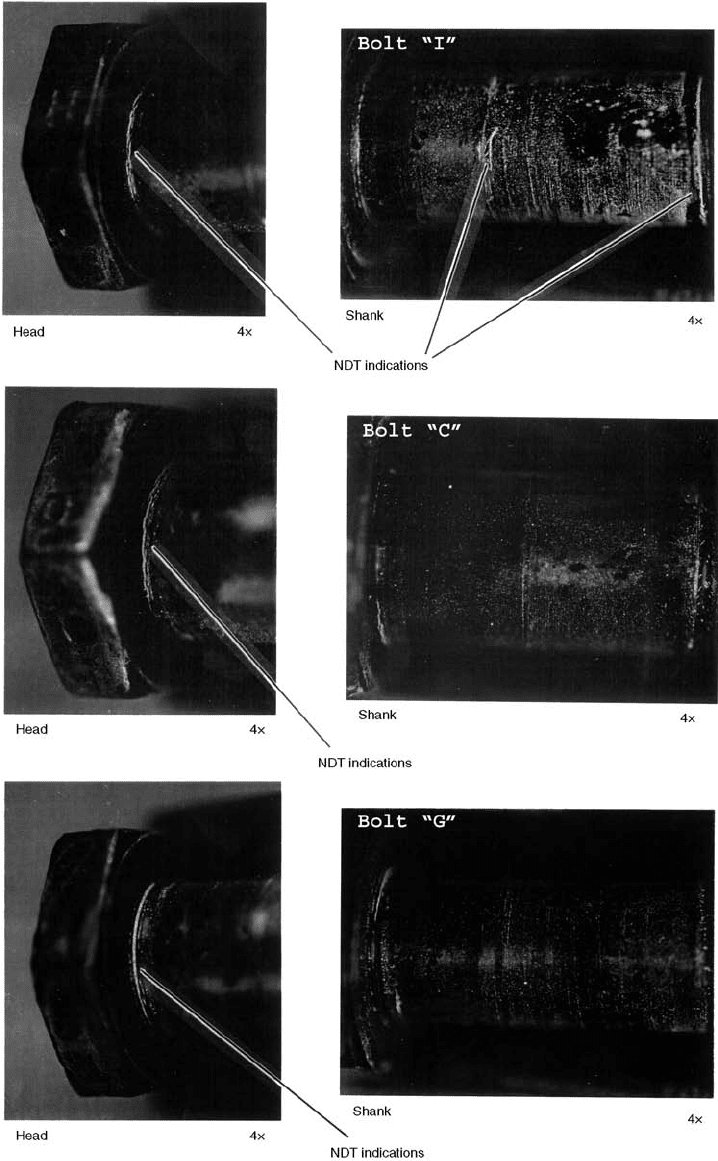
Fig. 68 Ultraviolet light photographs of magnetic particle indications for each bolt inspected. NDT, nondestructive testing
Case Studies of Steel Component Failures in Aerospace Applications / 387
Name ///sr-nova/Dclabs_wip/Failure_Analysis/5113_351-393.pdf/Chap_11/ 18/8/2008 3:48PM Plate # 0 pg 387
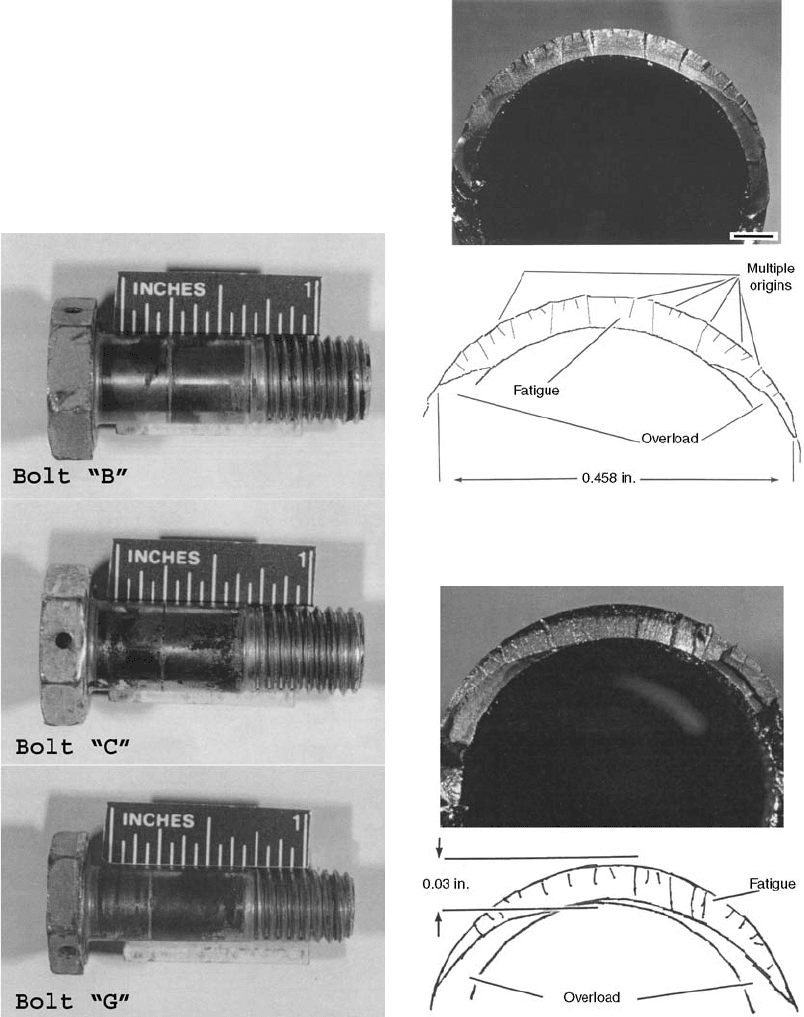
Bolt I (Fig. 72) showed scoring along the
circumference of the shank. In this bolt, crack
indications were found by NDT in both the
shank and the head. The exposed shank crack is
shown in Fig. 73. The shank fracture surface of
crack I had the characteristic ratchet marks or
shear ridges that indicates multiple initiation
sites along the outer edge of the bolt. The shape
and appearance of the exposed crack was indi-
cative of fatigue. The crack indication in the
head-to-shank fillet radius of bolt I was opened
in a similar manner as the other bolts, and the
fracture surface is shown in Fig. 74. The head-
to-shank fillet radius fracture surface had the
characteristic ratchet marks or shear ridges that
indicate multiple initiation sites along the outer
edge of the shank fillet radius (Ref 9). The shape
and appearance of the exposed crack was indi-
cative of fatigue.
Fig. 69 As-received condition of bolts B, C, and G
Fig. 70 Fracture surface of bolt C with fracture schematic
Fig. 71 Fracture surface of bolt G with fracture schematic
388 / Failure Analysis of Heat Treated Steel Components
Name ///sr-nova/Dclabs_wip/Failure_Analysis/5113_351-393.pdf/Chap_11/ 18/8/2008 3:49PM Plate # 0 pg 388
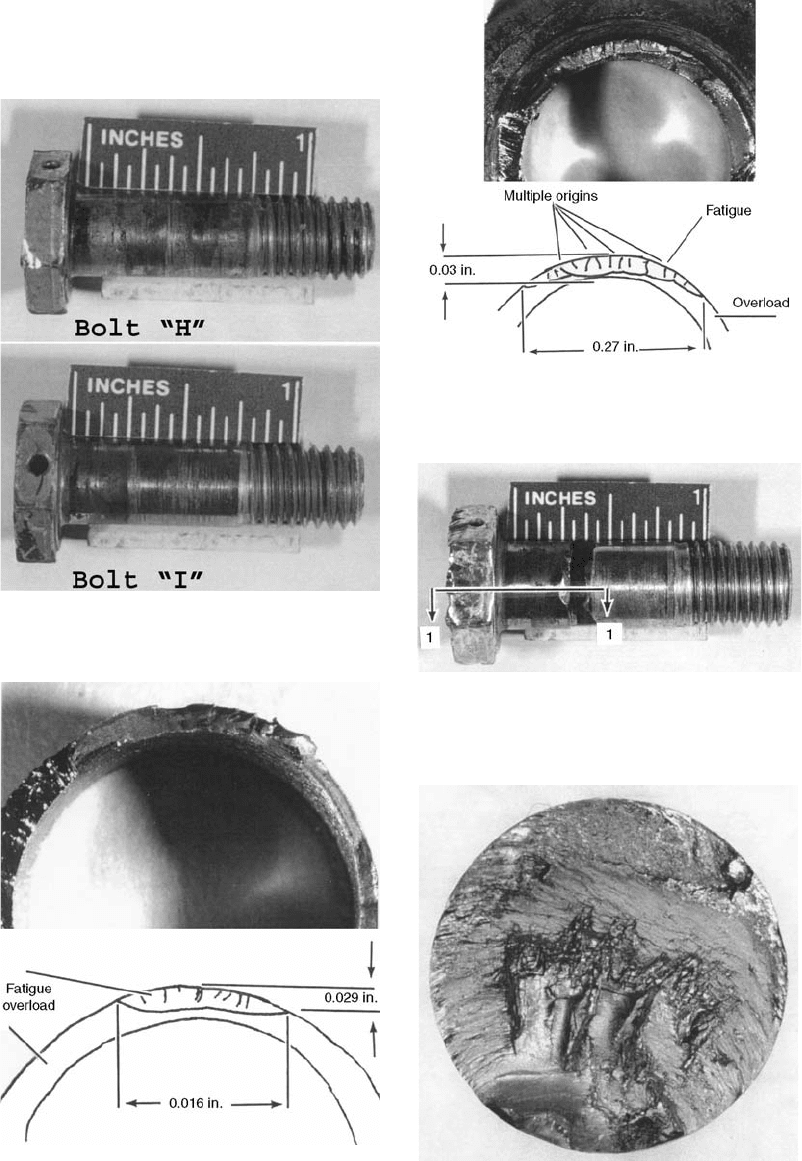
The as-received condition of bolt A is shown
in Fig. 75. A photograph of the fracture surface
of the failed bolt is shown in Fig. 76. The
Fig. 72 As-received condition of bolts H and I
Fig. 73
Fracture surface of the exposed crack in the shank of
bolt I
Fig. 74
Fracture surface of the exposed crack in the head
fillet radius of bolt I
Fig. 75 As-received condition of the failed bolt
Fig. 76 Fracture surface of the failed bolt
Case Studies of Steel Component Failures in Aerospace Applications / 389
Name ///sr-nova/Dclabs_wip/Failure_Analysis/5113_351-393.pdf/Chap_11/ 18/8/2008 3:49PM Plate # 0 pg 389
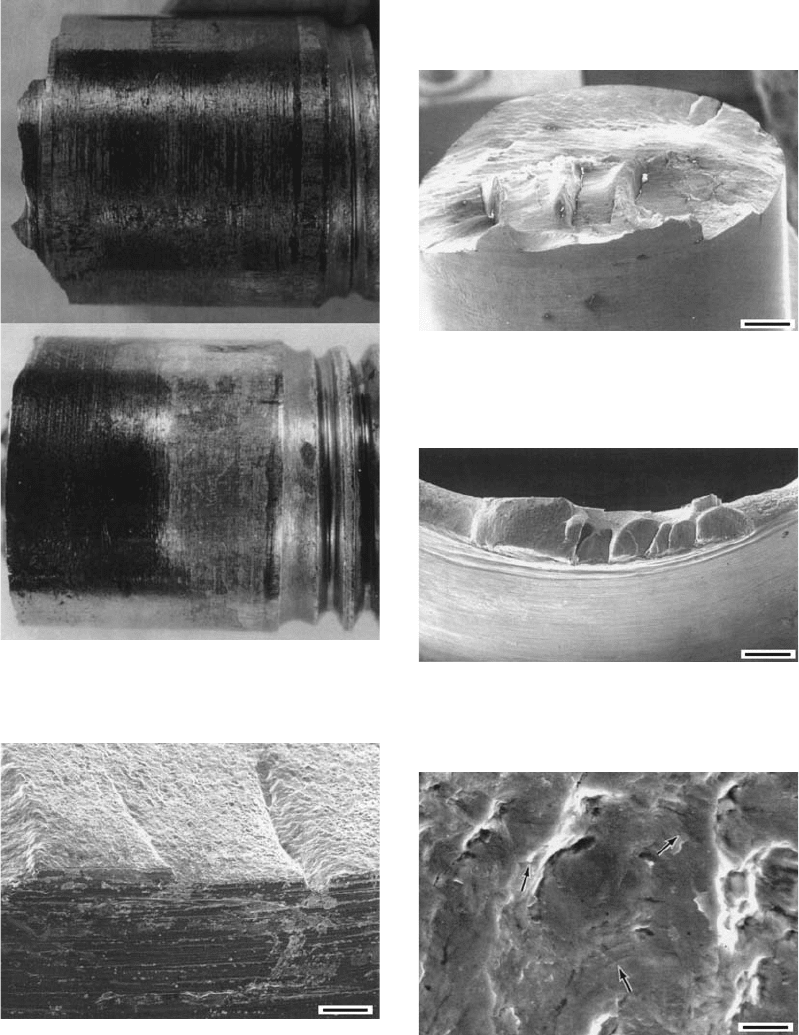
fracture surface shows ratchet marks that are
characteristic of fatigue origins. Multiple fatigue
origins, located to one side of the bolt, were
observed. A large fatigue zone was apparent.
The final fracture zone was badly damaged. The
bolt showed evidence of machining marks on the
sides of the shank at the site of crack initiation
(Fig. 77). Opposite the initiation site, on the side
of the shank, the surface appeared to be polished,
Fig. 77
Machining marks and polishing evident on the shank
of the failed bolt
Fig. 78
SEM micrograph of representative multiple fatigue
origins associated with machining marks on exposed
cracks (100 mm)
Fig. 79
SEM micrograph of the initiation site of the failed
bolt, showing cracking beginning at the localized
surface wear (1 mm)
Fig. 80
SEM micrograph showing initiation of cracking on
the shank of bolt I at localized surface wear (400 mm)
Fig. 81
SEM micrograph of representative fatigue striations
found on the bolt fracture surfaces (2 mm)
390 / Failure Analysis of Heat Treated Steel Components
Name ///sr-nova/Dclabs_wip/Failure_Analysis/5113_351-393.pdf/Chap_11/ 18/8/2008 3:49PM Plate # 0 pg 390

with more evidence of machining marks
(Fig. 77).
The fracture surfaces on bolts A, C, G, and I
were examined using the SEM. The fracture
surfaces of the exposed cracks in the bolts were
characterized by multiple fatigue origins, initi-
ating along machining marks (Fig. 78). In the
fractured bolt, initiation of cracking began at a
region of localized wear and scoring on the
shank of the bolt (Fig. 79). This was also evident
in the initiation of cracking in the shank on bolt I
(Fig. 80). Striations, characteristic of fatigue,
were seen on the fracture surface of bolt A
(Fig. 81). Machining marks found in the head-
to-shank fillet radius were evidence that the
head-to-shank fillet radius was machined
(Fig. 82). This is unacceptable according to the
design specification.
A metallographic specimen was prepared
using standard techniques. This specimen was
used to examine the microstructure and micro-
hardness of bolt A. A photographic montage of
the metallographic specimen is shown in Fig. 83.
The tempered martensite microstructure of
bolt A was typical for quenched and tempered
low-carbon steel (Fig. 84). Bolt A failed in
the shank; in addition, a crack approximately
0.15 mm (0.006 in.) long was found in the head-
to-fillet radius (Fig. 85). Neither magnetic par-
ticle nor ultrasonic NDT detected this crack.
The failed bolt was submitted to a micro-
hardness survey to determine the extent of de-
carburization. The microhardness survey was
taken with a Knoop indenter, with a 500 g load.
Indentations were taken at 0.0318 mm
Fig. 82
SEM micrograph of machining marks at the head-
to-shank fillet radius of bolt I (1 mm)
Fig. 83
Microstructure at bolt A fracture through section 1-1.
The overall microstructure is shown as well as the
location of additional micrographs. There is no evidence of a
cold-formed head. Etched with 2% nital (667 mm)
Fig. 84
Micrograph of representative quenched and tem-
pered martensite found in the submitted bolts.
Etched with 2% nital (25 mm)
Fig. 85
Micrograph of the crack found in the head-to-shank
fillet radius of the failed bolt. Etched with 2% nital
(25 mm)
Case Studies of Steel Component Failures in Aerospace Applications / 391
Name ///sr-nova/Dclabs_wip/Failure_Analysis/5113_351-393.pdf/Chap_11/ 18/8/2008 3:49PM Plate # 0 pg 391
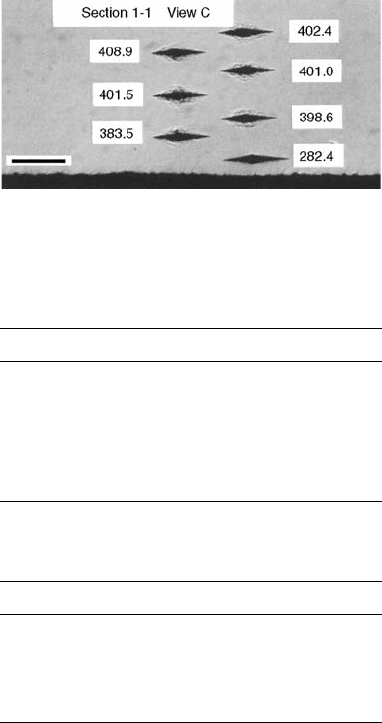
(0.00125 in.) intervals until the hardness read-
ings began to stabilize. The point at which the
hardness stabilized was called the core hardness.
For the failed bolt, the core hardness was 404
KHN. In accordance with the specification, the
point at which the hardness is within 20 KHN of
the core hardness is defined as the depth of
decarburization. For the failed bolt, this was at
0.064 mm (0.0025 in.) deep, meeting the spe-
cification requirements. The hardness indentions
are shown in Fig. 86. The results of the micro-
hardness survey indicated that the surface
hardness (Knoop), converted to Rockwell C, is
26 HRC. The Knoop core hardness, converted to
Rockwell C, is 40 HRC. While the partial de-
carburization of the bolt satisfies process speci-
fication requirements, the steep gradient of the
hardness profile and the surface softness mea-
sured indicated that there would be degradation
in the potential fatigue life of the bolts.
Determination of the composition of the
failed bolt was performed by arc-spark spec-
trometry. The carbon content of the steel was
determined by Leco carbon analyzer. Results are
shown in Table 6. The chemical results indicate
that this bolt does not meet the composition
requirements of Table 2 for any of the specified
bolt alloys.
The hardness of each bolt was measured using
standard procedures. The calibration of the
hardness tester was verified, using two calibra-
tion test blocks (54.1+1.0 HRC and 34.6+1.0
HRC). The measured hardnesses on the test
blocks were found to be within the range of the
hardness test block calibration. A section of
the bolt was taken by cutting perpendicular to
the long axis of the bolt, in the threaded region.
The hardness of each bolt was determined by
taking a hardness measurement on the end of the
cut section. Results are shown in Table 7.
Based on this investigation, it was conclu-
ded that:
Ultrasonic inspection does not have the
sensitivity to detect cracks of the size and
geometry seen in the bolts.
The fractured bolt failed by fatigue, initiat-
ing at localized wear on the bolt shank. The
soft surface hardness from partial decarbur-
ization aggravated the fatigue failure.
The exposed cracks in bolts C, G, and I
initiated at machining marks at the head-to-
shank fillet radius, and cracking propagated
by fatigue. Evidence of machining at this
radius was found. Bolt I had a second
initiation site on the shank.
The composition of the failed bolt did not
meet the chemical requirements of S105
bolts. However, the chemistry of the bolts is
not thought to have contributed to the failure
of bolt A.
The bolts were machined instead of cold
formed. This results in lower fatigue strength
and proof load.
REFERENCES
1. G.E. Dieter, Mechanical Metallurgy, McGraw-
Hill, Inc., 1986
2. Met allography and Microstructures, Vol 9,
Metals Handbook, 9th ed., American Society
for Metals, 1985
3. D.A. Ryder et al., General Practice in Failure
Analysis, Failure Analysis and Prevention,
Fig. 86
Micrograph of Knoop hardness (500 g load) survey of
failed bolt (100 mm)
Table 6 Measured chemistry of the failed bolt A
Element
Percent,
wt%
C 0.42
Si 0.32
Mn 0.82
P 0.010
S 0.014
Cr 0.49
Mo 0.15
Ni 0.45
Table 7 Measured hardness of submitted bolts
Bolt
Hardness,
Rockwell C
C 43.4
B 36.4
H 41.6
G 40.4
I 39.2
Failed bolt A 36.9
392 / Failure Analysis of Heat Treated Steel Components
Name ///sr-nova/Dclabs_wip/Failure_Analysis/5113_351-393.pdf/Chap_11/ 18/8/2008 3:49PM Plate # 0 pg 392
Vol 11, Metals Handbook, 9th ed., American
Society for Metals, 1986
4. B.E. Wilde, Stress-Corrosion Cracking,
Failure Analysis and Prevention, Vol 11,
Metals Handbook, 9th ed., American Society
for Metals, 1986
5. W.J. Jensen, Failures of Mechanical Fast-
eners, Failure Analysis and Prevention, Vol
11, Metals Handbook, 9th ed., American
Society for Metals, 1986
6. Threaded Steel Fasteners, Failure Ana-
lysis and Prevention, Vol 11, Metals
Handbook, 9th ed., American Society for
Metals, 1986
7. A.G. Glover et al., Failures of Weldments,
Failure Analysis and Prevention, Vol 11,
Metals Handbook, 9th ed., American Society
for Metals, 1986
8. E. Alban, Failures of Gears, Failure An alysis
and Prevention, Vol 11, Metals Handbook,
9th ed., American Society for Metals, 1986
9. R.J. Parrington, Fractography of Metals and
Plastics, Pract. Fail. Anal. Vol 2 (No. 5),
2002, p16
Case Studies of Steel Component Failures in Aerospace Applications / 393
Name ///sr-nova/Dclabs_wip/Failure_Analysis/5113_351-393.pdf/Chap_11/ 18/8/2008 3:49PM Plate # 0 pg 393

Failure Analysis of Powder Metal
Steel Components
S. Ashok and Sundar Sriram, Sundram Fasteners Ltd.
POWDER METALLURGY (PM) technol-
ogy provi des a cost-effective method of produ-
cing near-net shape products, especially when
a large number of the same or similar products
are required. While the initial powder used
is expensive compared to wrought steels, the
manufacturing process can avoid machining
steps and provide more uniform composition
control. Total cost of producing PM parts can be
less expensive than conventional metalshaping
(casting, forging) in many cases. It was first
adopted by the auto industry. Since this initial
inception, other industries, such as the refri-
gerator, lawnmower, and hand tools industries,
have also extensively adopted PM parts (Ref 1).
Manufacture of powder metal parts involves
pressing of metal powder in a die, sintering
the green compact so that metallurgical bonding
takes place, sizing or coining for densification
and dimensional correction, followed by finish-
ing operations. The finishing operations include
machining, case and through hardening, steam
treatment, and so on (Ref 1).
This chapter reviews failure aspects of struc-
tural ferrous PM parts, which form the bulk of
the PM industry. Focus is on conventional PM
technology of parts in the density range of 6 to
7.2 g/cc. This constitutes 90% of the parts pro-
duced by PM technology.
The PM part undergoes multiple heat treat-
ments, some of which are unique to PM while
others are similar to that used by conventional
manufacturing processes, such as forging and
casting. These include:
Powder annealing
Sintering
Case hardening
Carbonitriding
Case carburizing
Through hardening
Induction hardening
Steam treatment
This chapter briefly introduces the processing
steps involved in PM (Fig. 1). These heat treat-
ments and the PM process steps are essential
to understanding failure analysis of PM parts.
The methods used for analyzing the failures are
then discussed. Methods of failure analysis itself
have recently become more systematic in terms
of prevention and ensuring more robust process
and high-quality products. Some case studies
are given that illustrate different failures and the
methods of prevention of these failures.
Powder Metallurgy Process
Powder Production. Solid-state reduction
of iron ore and atomization of molten iron are
the most common methods of producing iron
powders for structural parts. The powder thus
produced should be favorable for compaction
such that:
It fills the die cavity repeatably, which is
measured in terms of the apparent density
and flow rate of the powder.
It can be compressed to the desired density
with the lowest pressure, which is measured
in terms of compressibility.
It has sufficient strength at that density so
that the green part can be handled, which is
measured in terms of its green strength.
The filling characteristic of a powder is
measured by its apparent density and its
flow rate. The compressibility of a powder is a
function of the particle morphology, processing
history, and purity. Water-atomized iron pow-
ders can be compressed to highe r densities
compared to sponge iron powder. The higher
the impurity content (typically oxides), the
poorer the compressibility. As a process, all iron
powders are general ly annealed in a reduc-
ing atmosphere. Special high-compressibility
Name ///sr-nova/Dclabs_wip/Failure_Analysis/5113_395-415.pdf/Chap_12/ 18/8/2008 3:51PM Plate # 0 pg 395
Failure Analysis of Heat Treated Steel Components
L.C.F. Canale, R.A. Mesquita, and G.E. Totten, editors, p 395-415
DOI: 10.1361/faht2008p395
Copyright © 2008 ASM International®
All rights reserved.
www.asminternational.org
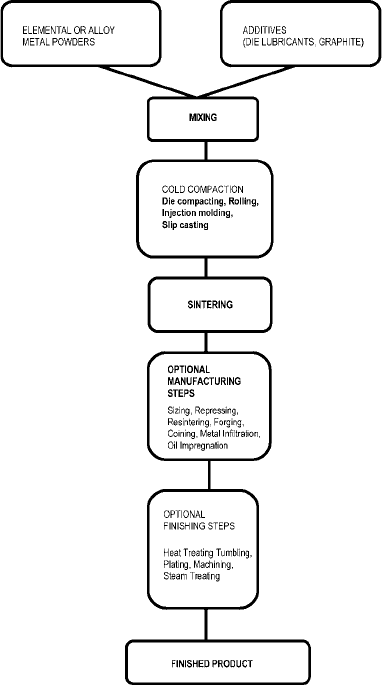
powders are produced by double-annealing
operations.
Blending. Alloying elements are typically
mixed with the iron powder by blending in
a double-cone blender. Elemental addition of
alloying elements, that is, graphite, copper, or
nickel, has its drawback, because these elements
tend to segregate in the product as the alloying
element content increases. A recent develop-
ment in this regard is the introduction of diffu-
sion-bonded iron powder and binder- treated
premixes. These processes are proprietary. For
example, the Distaloy process is diffusion
bonding of nickel, molybdenum, and copper to
iron powders developed by Hoganas AB, Swe-
den. The Ancorbond and Starmix methods are
binder treated premixs to reduce graphite-
lubricant segregation. In the case of diffusion-
bonded iron powders, the alloying elements,
typically copper, nickel, and molybdenum, are
mixed with iron, and the mix is annealed at
a temperature of approximately 850 to 920
C.
As a result, bonding of the alloying elements
to the iron particle takes place, and this pre-
vents segregation of alloying elements in the
products. The same principle is used to prevent
carbon-lubricant segregation. In this case, the
binder, which is added during powder mixing,
is sprayed on the iron-carbon mix. This binder
ensures that each iron particle has a coating
of graphite and thus minimizes segregation.
Case studies in this chapter illustrate this
mechanism.
Compaction. The most widely used method
of compaction is axial pressing of loose powder.
Initially, the die cavity is filled with the loose
powder from a hopper by gravity; the density is
typically the apparent density of the iron pow-
der, whi ch is 2.4 to 3 g/cc. When compaction
commences, that is, the punches move toward
each other, densification takes place by particle
rearrangement and plastic deformation. Thin
sections of individual particles bend or break,
cold welding and interlocking of n eighboring
grains takes place, and the voids are filled by the
material, which becomes squeezed into them.
The density of 5.5 g/cc is the lowest density
of iron powder parts fit for practical handling in
the green stage. On attaining this density, a rapid
increase in pressure is observed when the part is
compacted to densities between 6 and 7.2 g/cc.
Compacting in the higher-density range gradu-
ally increases the rate of plastic flow of the
metal. This results in the following:
Increased work hardening of powder parti-
cles
Increased friction against the die walls
Structural ferrous powder metal parts typi-
cally have sections of varying thickness. With
respect to heat treatment, it is very important that
all sections in the parts have uniform density
throughout. Low sectional densities result in
through hardening and wide variation in the case
depth within the PM part. Various methods of
compaction have been developed to produce
parts with minimal difference in density. These
include:
Double-action compaction
Spring floating die compaction
Compaction by withdrawal process
Multilevel compaction using multiple mov-
ing p unches in special multiplaten presses
Fig. 1 The powder metallurgy process
396 / Failure Analysis of Heat Treated Steel Components
Name ///sr-nova/Dclabs_wip/Failure_Analysis/5113_395-415.pdf/Chap_12/ 18/8/2008 3:52PM Plate # 0 pg 396
